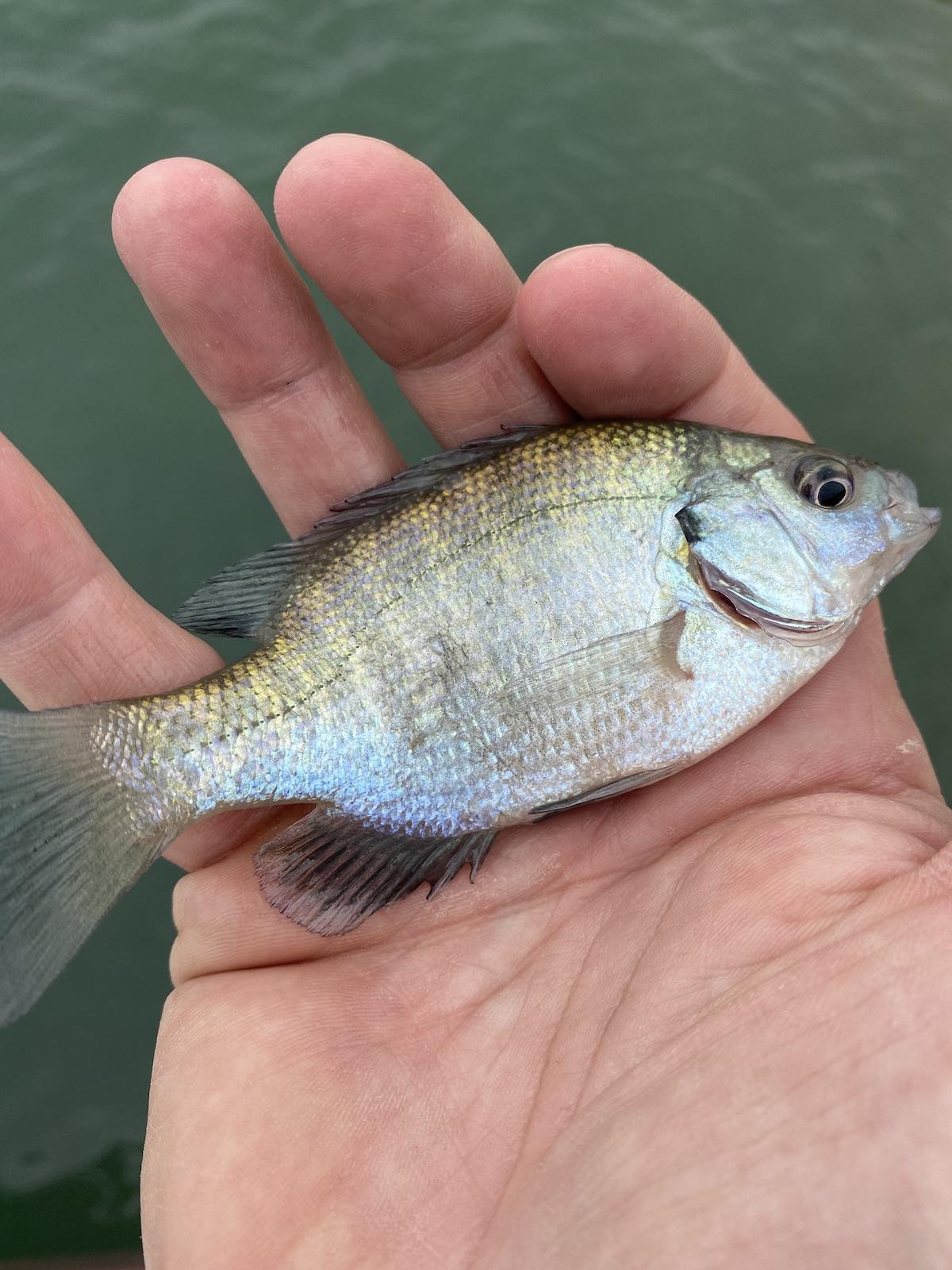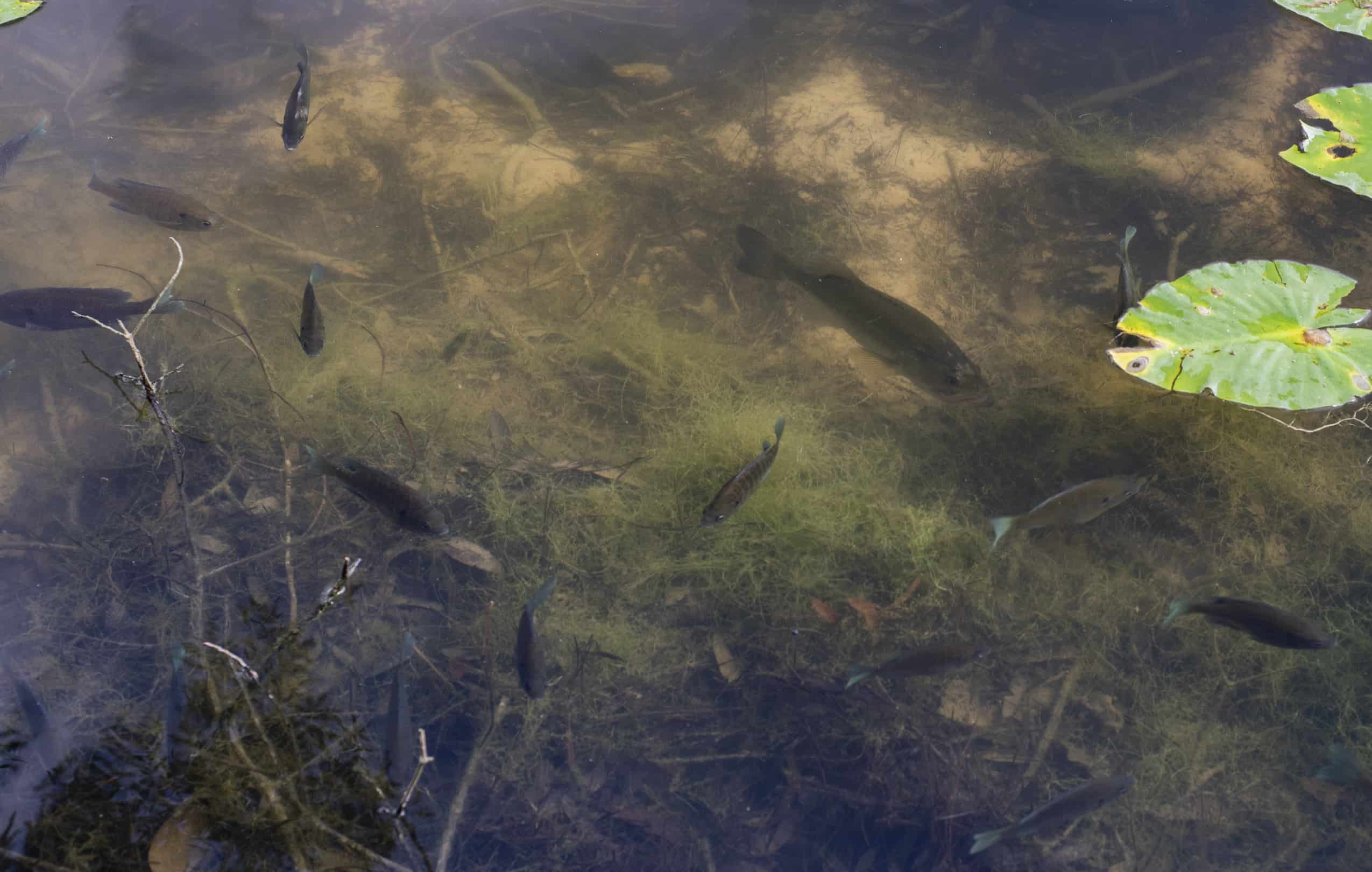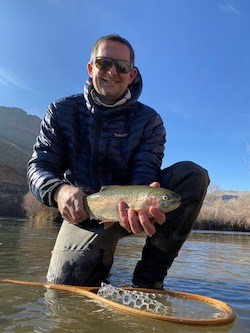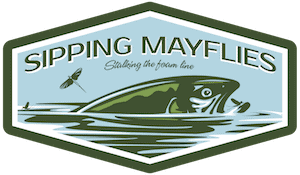Fly fishing in ponds | flies AND TECHNIQUES
Dec. 10th, 2021
When I was growing up, we lived next to several large natural ponds—some were deep, some were shallow, and I could catch fish in all of them. I even tried to turn one pond into a northern pike sanctuary. It didn’t work, but I tried.
As an adult I’m blessed to now have a pond full of game fish right on my property. Over the years I’ve spent countless hours fly fishing in ponds and have learned strategies, tactics, and fish behavior that I’ll now share with you.
One of the biggest advantages of fishing a pond is that there are no crowds. Ever. There are plenty of times I’ve been frustrated by the maddening numbers of fisherman on popular rivers. But I’ve never had that problem on a pond.
Tying in with that, another big advantage of pond fishing is that, because there are no crowds, the fishing pressure is minimal. In other words, the fish are usually less picky and easier to catch.
Let’s dive into some of my favorite tips for fly fishing in ponds, including some easy tactics and techniques, the best flies, appropriate gear, and the types of fish you can expect to catch.

Here’s a young female bluegill sunfish I caught in a nearby pond using a size 18 pheasant tail nymph.
How to find fishable ponds
Ever expanding suburban development has its drawbacks, but one silver lining is that ponds are being added to these areas with increasing frequency. Business parks almost always have ponds.
Don’t forget about farm ponds. Farm ponds can be incredibly productive, usually for catching largemouth bass.
Don’t trespass, and adhere to any signs prohibiting fishing. As fly anglers, we need to protect our good reputation. You’ll often find that people are fascinated by fly fishing and are more open to allowing it on their property. Bring them a gift, and your chances increase.
Some local ponds are located entirely within a private lot, in which case you can ask the homeowner for permission. The younger you are, the better your chances of getting a nod. Bring your kids, and your chances skyrocket.
Golf courses are one more spot I’ll mention—they almost always contain several ponds, and the ponds always hold fish. But, they usually don’t allow fishing. If possible, get to know the ranger or greenskeeper(s). When I was in college, I worked at a golf course during summer and had all the access I wanted. Food for thought.
Use Google Maps to fly over your city and you’ll find plenty of ponds that hold fish. Personally, my favorite ponds are always the ones I find on public land, usually in the woods.
In the below picture, you can quickly see that panfish and largemouth bass are waiting for your fly. It’s going to be a good day.

Deep ponds tend to hold more fish than shallow ponds for two main reasons.
Firstly, because the water column offers a wider temperature gradient, a greater variety of species can survive.
Secondly, the greater volume of water allows for more prey items and a larger biological load.
Shallow ponds tend to get quite warm during the summer months, which is fine for panfish, carp, and largemouth bass. But several other pond species prefer slightly cooler water, namely trout.
What species of fish live in ponds?
Ponds are synonymous with panfish, but the truth is most local ponds also contain largemouth bass. I’ve fly fished ponds in different states, and I’d say the most common combination of available fish are sunfish and largemouth bass.
Technically the sunfish family also includes smallmouth bass, largemouth bass, white crappie, and black crappie, but for purposes of this conversation, when I say “sunfish” I’m referring to panfish such as bluegills, pumpkinseeds, green sunfish, and redear sunfish.
The most common fish to find in ponds include all species of panfish, largemouth bass, and white crappie. Less common fish to find in ponds include smallmouth bass, black crappie, and perch. (White crappies can more easily adapt to murkier water than black crappies.)
If you’re into chasing big pond fish, read my article on fly fishing for carp.
Along with the above species, it’s not unusual to find both common and grass carp in ponds, especially golf course ponds (for whatever reason). You might also occasionally see koi in ponds—they’re just another form of carp and can be caught using the same methods.
Catfish and suckers also thrive in ponds, but they’re more challenging to catch with a fly.
The above fish are all considered warmwater species.
How do fish get into ponds?
I mentioned earlier that I used to work at a golf course—it was during the summer while I was in college. I’d noticed there were largemouth bass, sunfish, and carp in each of the six or so landlocked ponds on the course.
So, one day I asked the head greenskeeper—he was an easy-going guy named Rich—if they planted fish in the ponds. I’ve never forgotten what he told me.
Rich said they didn’t plant the fish. Instead, the fish were the result of fish eggs that were stuck to the legs of ducks and geese that frequented the ponds.
It was an epiphany.
My mind raced back to years earlier when I was exploring in the woods near the home where I grew up. I came across a small pond—it might’ve been 30-feet across—that had dried-up. But, I saw several spawning beds on what had been the pond’s bottom.
It was baffling—for years I’d wondered how fish could’ve possibly gotten into a secluded seasonal pond like that. Now I had my answer.
It may also have explained why, when we were on vacation, I saw young Tarpon living in a freshwater pond in Florida that was nowhere near any other body of water.
Other times, ponds are simply fed by small streams that carry fish.
When I was about 12, the craziest day of fishing I’d ever experienced up until that point was at a small inlet-fed “pond” off the Mississippi river. I suppose it wasn’t a pond in the strictest sense of the word, but the narrow inlet dead-ended into a pond-like body of water that was full of big fish.
Gear for fly fishing in ponds
Ponds can contain big fish—don’t let anyone convince you otherwise. Some of the biggest largemouth bass I’ve ever caught were in local country ponds.
With that said, fly fishing in ponds doesn’t require heavy gear—but heavy enough for the occasional big fish. I’d personally recommend a three or four-weight fly rod, with fly line of matching weight. A five-weight rod is more stick than you need, but if that’s all you have, it’ll work just fine. I’ve used a five-weight on ponds many, many times.
Remember, in many ponds you’ll be sight-fishing and will be landing your flies along the shoreline. So, you’ll rarely need to make long casts.
Fly reels aren’t a vital piece of equipment when it comes to fly fishing in ponds. With the exception of carp, you’re likely never going to need to put a fish “onto your reel.” In other words, you should be able to strip-in almost every fish you hook into. Don’t buy a junk reel, but there’s no reason to go overboard either. Most pond fish will never take out drag.
I’d recommend a 7.5 to 9 foot 6X leader with 2-3 feet of 6X tippet. A 5X leader and tippet works just fine too. Pond fishing doesn’t need to be overly technical, so don’t overcomplicate things.
Luckily, sunfish and largemouth bass aren’t leader shy. This means they aren’t easily spooked by the thickness of your leader.
You’ll want to bring some forceps for dislodging flies that get inhaled (most often by sunfish), some good line nippers, and polarized sunglasses for spotting fish.
I’m not a big fan of Tenkara rods—it’s a little too much like using a cane pole for my tastes. But, if you enjoy it, more power to you! What a convenient, compact fishing system. Don’t listen to anyone who disparages the method.
Tenkara rods do have one undeniable advantage—they’re unbeatable if you’re trying to ease your kid into fly fishing, with the goal of fostering a genuine love of our fine craft.
Try teaching your child the mechanics of the fly cast—good luck with that. This often leads to the indelible notion that fly fishing isn’t fun. It’s hard enough trying to explain casting to an adult.
Instead of sabotaging your kid’s future interest in fly fishing, get them a Tenkara rod and hit some ponds. I can tell you from experience that it’ll be much more enjoyable for both of you. And, they might even catch fishing fever.
I’m not saying I think Tenkara rods are just for kids—not at all. Yes, they’re well-suited for introducing kids to fly fishing. But, plenty of advanced fishermen and women think they’re a blast to use any day of the week, especially for really small bodies of water where casting a fly rod would be nearly impossible to do effectively.
How to fly fish in a pond
Before you start fly fishing in a pond, there’s a checklist of things you should do if you want to optimize your success.
When you approach a pond, do so carefully, and just observe things for a few minutes. Watch for moving or feeding fish, and get a feel for the environment. Are there bugs falling into the water? Look for optimal casting spots. Develop a plan. Too many people just walk up to the water and start casting.
Don’t bring a dog, either. I know, I know, your dog is the best. The thing is, your dog is going to run along the shoreline and spook the fish.
If you see an otter (yes, they frequent ponds, not just rivers), find another pond because you won’t catch anything while its in the water.
Pay attention to your movements—if you’re standing on a dock, avoid unnecessary noise. If you need to move to another spot on the pond, move slowly and avoid walking along the shore.
Stillwater fishing requires more careful fly casting (and wading). The reason is that surface disturbances are much more noticeable to fish when the water is still. It can instantly spook them. Even ripples.
One day when I was around 14, I went fishing with two friends—one was on my baseball team, the other on my football team. They were using conventional gear, and I was using my fly rod. We were casting to sunfish and largemouth bass holding in a narrow, shallow inlet stemming off a local lake.
After an hour or so of slow fishing, one of my friends joked that I was scaring all the fish away. Touche. I smiled; it was a fair jab. I wasn’t an accomplished caster at the time, and he was right—my fly line was hitting the water so hard that I was spooking all the nearby fish. Don’t do that.
If you pay attention, you’ll likely see largemouth bass patrolling the shorelines, especially during spring and summer, and even into fall. Largemouths spawn during the spring, and they’ll hit your surface and sub-surface flies like they haven’t eaten all winter. A beadhead woolly bugger fished with a jig motion is deadly effective.
One of the most fun aspects of pond fishing is getting to sight-fish. It can be riveting, like watching a series of events unfold. We’ll get into fly patterns in the next section, but technique-wise, if you’re using dry flies you’ll want to cast and then let your fly sit motionless for a few seconds. Your instincts might want to give it action, but resist.
Often times you’ll get a strike right away, especially from panfish. If you don’t, give the fly a little action, but not much. Just enough to trigger attention. Let it sit. Give it another slight tug. Contrary to what you might think, too much surface action drives pond fish away.
Long pauses can be key in triggering strikes.
Largemouth bass are often on the prowl for minnows, frogs, and other prey items. Here’s one thing I’ve noticed time and time again: if I see a bass interested in my fly, and I give it more action, the bass will immediately lose interest. It’s almost like there’s something instinctive telling them it isn’t natural movement.
So, I started to let the fly sit motionless when a bass approached. The result was more bass hook-ups. Not every time, but a definite improvement.
Fish usually don’t want to chase fast prey items if they can chase slower ones (this is especially true during winter). Fish must consume more calories than they burn, or they die.
Terrestrial flies often work really well on ponds. These are flies that resemble ants, spiders, caterpillars, and just about anything else that can fall into the water. They’re bigger, bulkier flies that attract the attention of glutinous fish.
Not long ago I was standing on the dock in our pond and I noticed a furry caterpillar had just fallen into the water a few feet away. I then watched a bluegill sunfish immediately rise and pluck the caterpillar from the surface.
You can “match the hatch” on a pond just like you would on a river or stream, so I tied-on a Griffith’s gnat fly. It’s usually used to imitate midges or other tiny insects, but to my eye, its appearance looked very similar to the hairy caterpillar I’d just seen fall into the water.
Bingo! I caught several sunfish in a row on that Griffith’s gnat fly—it was almost too easy to be fun.
Sunfish in ponds will eat bigger prey items than you might think. They’re voracious feeders.
When I was younger, I’d done some research and put together a grand plan to stock our pond with rainbow trout. So, I bought 100 trout fry (baby minnows) from a local fishery and gently poured them into the water off the end of the dock.
While I was admiring my work, a hoard of sunfish converged on the trout fry and demolished them. They didn’t eat all of them, but it was ugly, and in the months that followed I never did see any juvenile rainbow trout in the pond.
Speaking of aggressive pond fish, when you hook into a sunfish (or any smaller fish), be on the lookout for larger predatory fish.
One summer I caught a medium-sized sunfish in my pond and was casually stripping it in when I noticed a +/- 4lb largemouth bass closing in. The bass smashed the bluegill and began swimming off with my fish in its mouth.
The bass didn’t want to let go, and it was a good minute or so before it launched out of the water, shaking its head side-to-side, before the sunny flew out of its mouth.
I see this happen every year, but that particular summer it happened five different times.
Let’s talk about setting the hook. Fish living in ponds are no less intelligent than fish living in rivers, streams, and lakes. You need to be ready to set the hook at a moment’s notice, because these fish will quickly spit your fly out once they realize it’s not an insect—and that usually takes less than a second.
Another similarity between fly fishing in a pond and fly fishing in a river, stream, or lake is the need to let the fish rest occasionally. This is more important in a small pond than a large pond.
It’s usually inevitable that you’ll eventually put the fish down. This means they’ll spook and stop responding to your flies. Your fly line slapping the water, or the commotion caused by wading or landing a fish, can contribute to spooking fish.
“Resting” a pond means taking a break and allowing the fish the recuperate and start actively feeding again. Take 15-30 minutes and eat lunch, read a book, or visit another pond.
Earlier in the morning, and later in the afternoon or early evening tend to be the most productive times to fly fish on a pond. You can catch plenty of fish in the heat of the midday sun—I’ve done so more times than I could count—but your best odds are earlier and later in the day.
Dry flies work best during the warmer months of the year, when insects are most active.
The best flies to use on a pond
Damselfly Patterns
Largemouth bass love damselfly and dragonfly patterns, especially with blue coloration. What’s the difference between damselflies and dragonflies? Damselflies are smaller and more fragile looking, usually around 1.5” long. Dragonflies are much bigger, sometimes ridiculously so. I once hit a dragonfly on my forward cast, and it felt like my rod hit an airborne rock.
Cast the damselfly pattern and let it sit on the surface. Don’t move it. If you don’t get a strike, twitch the fly. If the bass still hasn’t taken it, skitter it a few inches. Wait several seconds. Skitter it a few more inches. Then repeat.
Hoppers
Largemouth and smallmouth bass can always be tempted with hoppers. You’ll find frog patterns, mouse patterns, and everything in between. Bass aren’t very discriminating fish—don’t agonize over specific patterns. I’ve caught them on the gaudiest looking flies you’ve ever seen.
I highly recommend anything with rubber legs, such as a Chernobyl ant or Fat albert.
Poppers
There’s a reason “bass poppers” exist. And that reason is they work.
What’s the difference between a hopper and a popper? A hopper generally won’t sink—they aren’t designed to, either. A popper can be pulled below the surface in short bursts, but they’ll float back to the surface.
Poppers also have solid heads that push more water. Pushing water creates more disturbance, which fish can pick up on with their sensitive lateral line.
Sunfish seem to hit small poppers with a little more regularity than small hoppers, but they’ll hit both.
Elk Hair Caddis and Parachute Adams
Yes, both of these dry fly patterns are quintessential river flies, but they work really well on ponds too. Despite their specific names, they can imitate a ton of various insects, including moths, mayflies, spiders, drakes, crickets, grasshoppers, and so on.
You’ll catch more bluegills on these dry flies than anything else. They’re good producers and you should always have them in your fly box (if you don’t already).
I recommend these flies in sizes 12-18, depending upon the size(s) of the natural insects at the pond you’re fishing. The Adams comes in a parachute, and non-parachute style. Both work well.
One tip I can offer you is to use your nippers to trim-down your flies. You can make them sit lower on the water, for instance, or change their profile in other ways. Always experiment—it pays off.
Woolly Bugger
There’s a reason this streamer is one of the most popular flies in the country. I’ve heard fly anglers claim that no streamer will ever out-fish the Woolly Bugger. While it’s true that many streamers work well, this one keeps me coming back for more.
It’s possible that no other streamer has caught more fish than this pattern.
You can get the Woolly Bugger in many different sizes, many different colors, and with or without a beadhead. The number of variations is borderline overwhelming.
Black is the most widely used color, with olive or white a distant second. I recommend buying this streamer in sizes 8-14, depending upon the size of the fish you’re chasing. The higher the number, the smaller the fly.
The beadhead version is more prolific than the non-beadhead version, mainly because it’ll sink. This allows you to fish it off the bottom, or treat it like a jig.
Beadhead flies are easier for fish to throw than non-beadhead flies, but in a pond, I want the beadhead version every day of the week and twice on Sunday.
If you live near a golf course and like to chase carp, here’s a tip for you.
If you ever get the opportunity, pay attention to the ponds after the lawn mowers pass by them in the morning. If there are carp in the pond, they’ll often have learned to eat the resulting grass clippings off the surface. If nothing else, it’s fun to watch. I learned this at the golf course I worked at while I was in college.
Green drake dry flies worked back then, and they still work. You could even have a little fun and tie your own grass imitation.
Nymphs: Pheasant tail, Copper john, Hare’s ear
My personal preference is to use surface flies or streamers in ponds—it’s just more fun in my opinion. But nymphing can work well too.
You usually don’t get to see a fish take your nymph, so your reflexes need to be on high alert to detect a strike and set the hook before the fish spits-out your fly. This usually means using an indicator (bobber) of some sort.
Another method is to cast your nymph (or nymphs) and use a very slow retrieve, with or without an indicator.
I just can’t bring myself to use an indicator on a pond. Sorry, just can’t. But I do enjoy using a hopper-dropper setup.
A hopper-dropper rig is when you tie-on a dry fly trailed by a nymph. I often use a Chernobyl ant as my dry fly (or something similar), followed 2-4 feet by one of the above nymphs (Pheasant tail, etc).
So, you’re fishing a hopper on the surface, as well as nymph below the surface. This is a good experiment to determine if the fish are hitting things on the surface or sub-surface. You can then adjust your strategy accordingly.
Summary
Fly fishing in ponds isn’t an activity that requires much planning or drive-time, making it a great spur-of-the-moment option if you feel the itch to catch some fish.
I encourage you to experiment constantly. You’ll discover new methods and techniques and will become a better fly angler.
If you’re traveling for business or pleasure, bring your fly rod! What a great opportunity to try out new waters—ponds are never far away, and there’s something exciting about the mystery of a new body of water.
And you know what? If the fish aren’t cooperating, you can practice your fly casting. I honed my fly casting on the pond in our backyard over the course of many, many hours. I’d try to drop my fly on specific targets—it’s fun. Occasionally I’d inadvertently catch a fish.

About the Author
My name's Sam and I'm a fly fishing enthusiast just like you. I get out onto the water 80+ times each year, whether it's blazing hot or snow is falling. I enjoy chasing everything from brown trout to snook, and exploring new waters is something I savor. My goal is to discover something new each time I hit the water. Along those lines, I record everything I learn in my fly fishing journal so I can share it with you.
Follow me on Instagram , YouTube, and Facebook to see pictures and videos of my catches and other fishing adventures!


